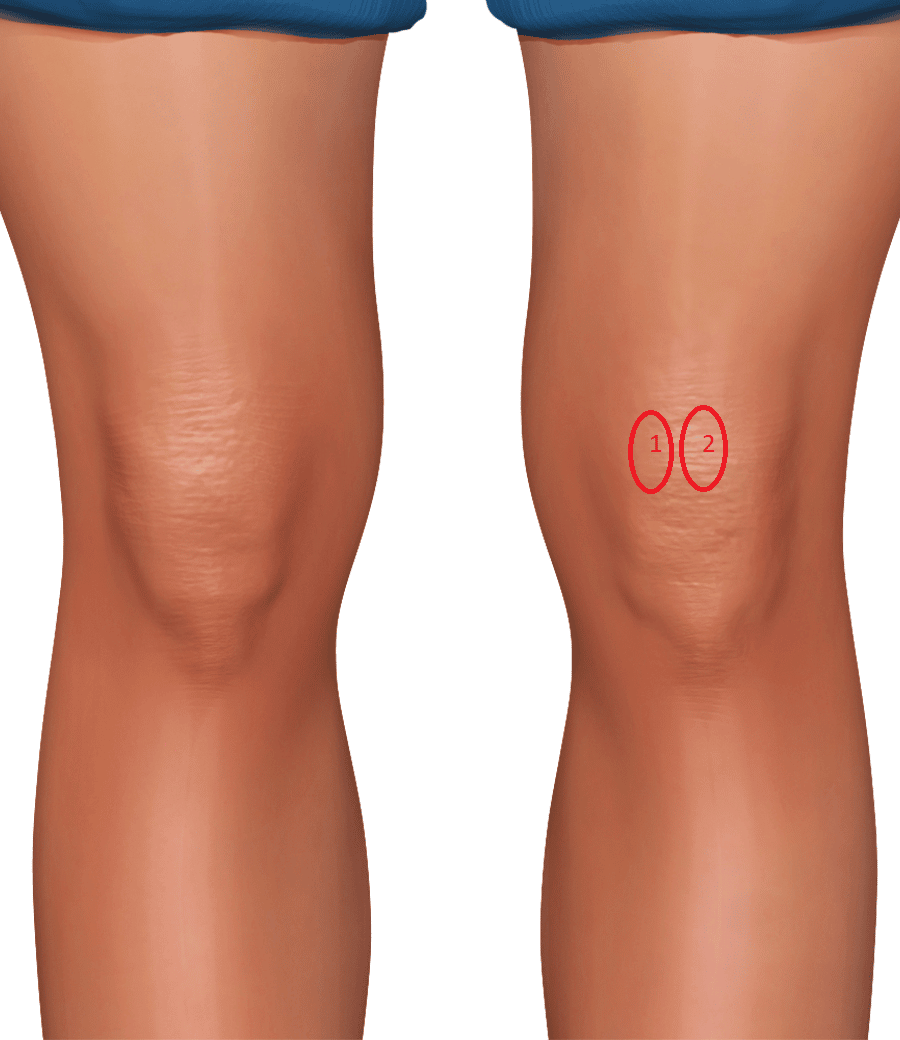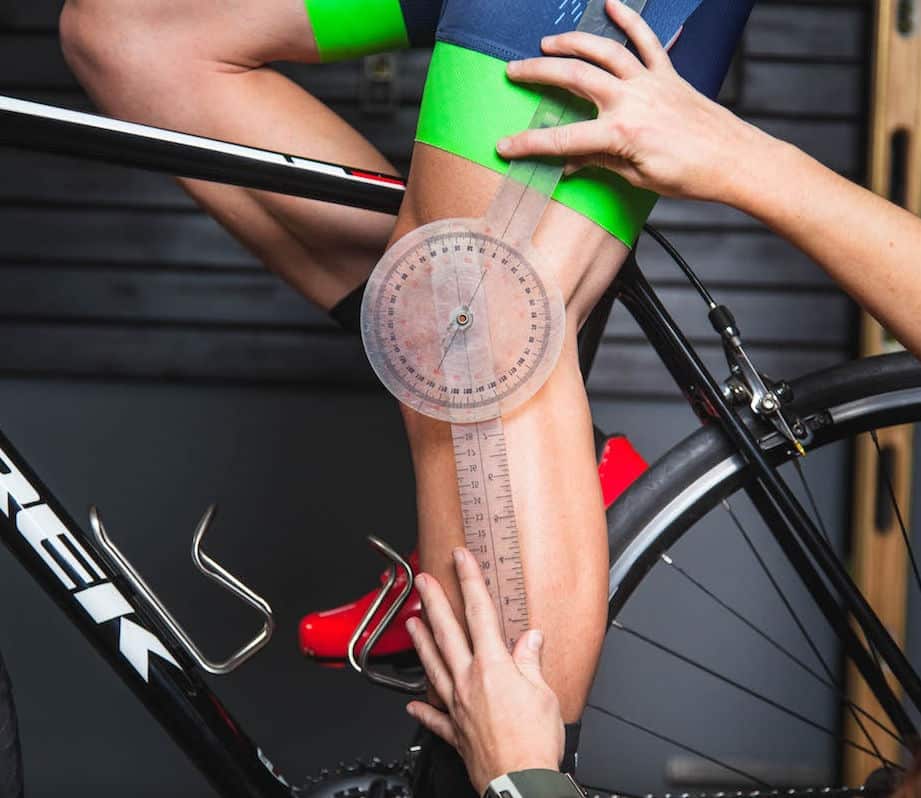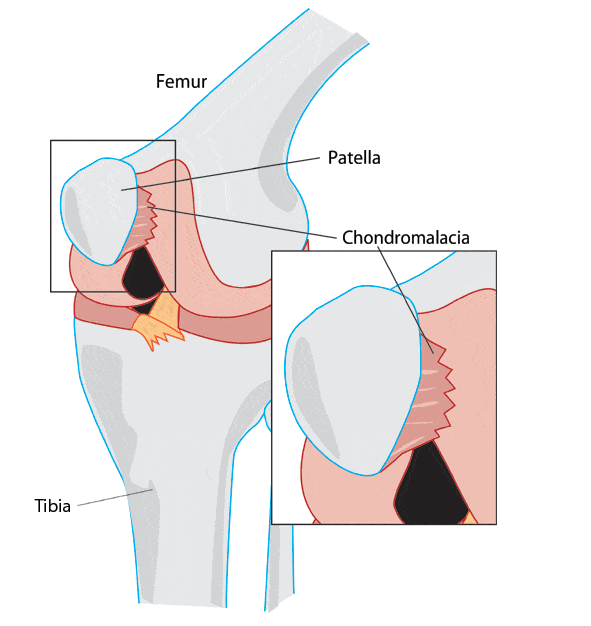When The Saddle Is Too Low
Were used to hearing about proper saddle height referenced by the measure of the knee angle at the bottom of the pedal stroke. Determining how straight the knee gets at the bottom of the stroke can go a long way toward determining if saddle height is correct.But tissue on the front of the knee, where most knee discomfort originates, is stressed not at the bottom of the pedal stroke, but at the top. At the top of the stroke, the knee is flexed maximally in the pedal cycle, which stretches the quadricep muscle, quadricep tendon, patellar tendon and increases compressive forces on the patella and sub-patellar cartilage. Because this is where we begin to put real force through the pedals, these tissues are being asked to contract and produce force while being flexed maximally as well. This is a perfect scenario for tearing of tissues to occur as well as compression of the patella into the femur.The lower saddle height is, the more knee flexion occurs at the top of the pedal stroke. Going even a few millimeters below optimal saddle height can strain these tissues and create knee pain.Most cyclists have a narrow range, perhaps 1-3 cm, where saddle height is agreeable to their overall mechanics and problems dont surface. Go below, or above, this and aches, pains, numbness and other problems will present themselves.
Let’s Go Over Some Basic Bike Fit Fixes
Power generation is independent of crank length — you dont get more power by simply having longer crankarms
Most research shows that wildly varying crank length doesnt have a dramatic impact on many measurable variables of mechanical efficiency at least in the short term
Theres no evidence that having cranks that are too short make you prone to injury, but having cranks that are too long can certainly create problems for some.
cycling knee pain
Bike Fit Issues And New Gear Saddle Shoes And Cleats
Knee pain in cycling due to cleat position or saddle position is normal. Thankfully, you can address many causes quickly, with minor adjustments doable at home. Nonetheless, visit a professional for an anatomically accurate bike fit that maximizes performance.
If you purchase new shoes, cleats, or even a new bike, you need to set them up to replicate the previous ones draw a line around your old cleats before removing them. In addition, record the position of your saddle in relation to the bottom bracket and handlebars of your old bike to use as a starting point for setting up a new one.
Make sure that your bike seat is set to the correct height, as a poorly fitted saddle will cause various types of knee pain.
Also Check: What To Do When My Knee Hurts
Standing Leg Abduction Glute Medius
Understanding The Knee Joint

The knee, a hinge joint, is one of the most complex joints in the body and the most utilized in cycling.
Four bones meet at the knee, including the femur, patella, tibia, and fibula. Big muscle groups such as the hamstring, calf, shin, and quads all connect around the area. In addition, the TFL and glutes play a significant role in knee positioning.
When these muscles are overused, they become tight, resulting in added pressure elsewhere in the system.
Although many muscles and bones meet at the knee, most injuries first show symptoms in the connective tissues, the largest of which include:
- Cruciate ligamentsAnterior and posterior ligaments connect the tibia to the femur and stop them from sliding too far backward or forward
- Collateral ligamentsMedial and lateral ligaments on either side of the femur stop it from moving too far on either side
- Patellar tendon Connect the patella to the quads
- Iliotibial band Runs from the pelvis to knee and stabilizes the leg, among other functions
- Meniscus cartilage Tissue that acts as a shock absorber between the leg bones
Connective tissue is particularly susceptible to irritation and damage due partly to the poor blood supply and the less robust structure, meaning repair can take much longer, and damage occurs easier.
The knee goes through an incredible amount of repetitive movements during a bike ride, resulting in repetitive strain injuries instead of tissue tears or strains, as you see in other sports.
Read Also: What Are The Best Volleyball Knee Pads
Gluteus Medius Strengthening Exercises For Cyclists
Getty
The following exercises are all designed to strengthen the gluteus medius muscle an important core abductor of the hip, often neglected by cycling.
Its a smallish muscle which, when contracting, can be felt as a lump at the top of the scoops of your buttocks its a good idea to place a hand on this area when doing the exercises, to make sure youre exercising it.
When Should You Seek Medical Help
The purpose of this guide was to inform you about all the problems associated with a cyclists knee and how to treat those problems but the internet has limitations.
If you are experiencing this problem for a very long time, or havent been able to find a proper cure then it is advised that you seek the help of a physiotherapist or medical professional. Even Professional Bike Fit Experts will be able to help you out, so do try them out!
Read Also: How To Run Without Hurting Knees
When Is Cycling Bad For The Knees
Only when you do it the wrong way. In fact, cycling is easier on your joints compared to other activities like running. And cycling-related knee injuries are mostly due to overuse or uneven loads. Oftentimes, these are due to accumulated trauma from bad habits that include:
- Poor bike fit and cleat placement
- Drastically increasing your training load
The Knee Is A Complicated Joint
It’s important to remember that the knee is effectively a hinge between the hip and the ankle. It’s very rare that the problem is actually with the knee itself.
Monger-Godfrey explains: “There are so many structures involved that mean the pain is localised to the knee but you need to look at the ankle, hip and lower back. Because its so complicated, its great to treat because you often get a really good response rate.”
Don’t Miss: Maci Knee Surgery Success Rate
Pain In The Back Of The Knee
Pain behind the knee is less common than pain in the front, and is generally easier to trace back to a culprit: over-extending the knee, says Bresnick. Your saddle is too high or too far back. Try lowering the saddle a bit or moving it forward a bit in relation to the handlebars, she says.
This pain is also more common among cyclists who spend a lot of time on fixed-gear bikes when you ride fixed, you use your hamstrings to decelerate your pedal stroke, which can put the biceps femoris tendon under too much load and irritate it. Giving your legs a break with some freewheeling now and then can also help.
Related Story
Focus On Pedal Stroke
Look at video of the pros in action, and youll notice their rapid and fluid pedal strokes. Try this drill to improve your pedal stroke: The next time you are going up your favorite climb, use a gear at least two teeth lower than usual. This higher cadence is easier on your joints. Think about making round circles as you pedal, not ovals.
Don’t Miss: When To See Doctor About Knee Pain
A Quick Note On Foam Rolling Massage And Stretching:
Foam rolling and stretching the ITB has been popularised as treatment for ITBS. Remember, the ITB is not a contractile structure and cannot be stretched or deformed. Therefore, massage and rolling will not directly change ITB length or break down knots. Trying to stretch or roll out the ITB will only cause greater tensioning of the fascia and compression of the fatty tissue beneath.
Insufficient Rest And Recovery

Concerning the point above, insufficient rest and recovery between training sessions is a sure way to cause damage to your muscles and joints. The stress of cycling increases the bodys need for good quality sleep and nutrition, so taking a day or two off between hard sessions will help you come back stronger than before.
In addition, many competitive riders use relaxed recovery sessions between harder ones these rides can promote recovery too. You can also try using a sauna, cold showers, or cross-training to aid recovery and rest.
Recommended Reading: How To Avoid Runner’s Knee
Lateral: Outside Knee Pain
The experience of outside knee pain from cycling is roughly as prevalent as anterior knee pain. Many large muscles and connective tissues meet along the outside of the knee, meaning imbalances or tightness in the muscles above or below frequently manifest as lateral knee pain.
Your cleat and pedal setup is a likely cause of lateral knee pain, especially if discomfort arises upon switching to clipless pedals, buying new bike shoes, or changing cleats.
Poor Technique Tightness Muscle Imbalance Injury
Poor technique such as riding with your knees too far apart can cause medial knee pain. Tightness, muscle imbalance or an old injury can throw alignment off and cause your knee to track poorly and instead of moving in a perfect linear circle it can move laterally as well, opening you up to potential inner knee pain.
If your knee is moving side to side while pedaling, it will likely just be a matter of time before you start to feel a twinge. Try spinning rather than mashing. Really focus on your pedaling technique, and making sure that you are stretching properly .
Recommended Reading: How To Reduce Inflammation In Knee
How To Avoid Anterior Knee Pain
A few issues are known to cause pain in the front of the knee while cycling stemming mostly from bike fit, muscle issues, or training mistakes.
Bike Fit
Firstly, if your saddle is too low or too far forward, you may experience pain from the extra pressure on the anterior knee. Another common problem is crank length if they are too long, more pressure goes through the front of the knee. Therefore, make sure to do a proper bike fit at home or visit a professional bike fitter.
Weak or Tight Quads
Imbalances from a weak or inactive vastus medialis oblique quadriceps can result in anterior knee issues. This muscle can be underdeveloped because the VMO typically activates fully in the final part of a leg extension, and a cyclists leg never fully extends while pedaling.
Using the strength training described at the end of this article, you can usually help correct this imbalance.
Tight muscles can also lead to imbalanced pressure distribution, leading to more strain on one area. Cycling disproportionately tightens the mid and lateral quads muscles, possibly causing problems down the line.
Mobilization, stretching, and massage can help improve function and reduce unwanted stiffness in muscles.
Training Mistakes
Finally, a couple of common training mistakes may cause anterior knee injuries.
What Are The Treatments/solutions For Anterior Knee Pain
Now the readers must be thinking, How To Relieve Anterior Knee Pain? The answer to that isnt that simple because there are a lot of treatments that one can follow. These different solutions and treatments, including physical therapy, will relieve pain that persists in cyclists.
The patellofemoral joint is a complex part of the body, that is why not all of the treatments will be viable if people have problems in that area. The thigh muscles also have to be taken care of properly, we advise our readers to consult with medical professionals before trying out a treatment.
The first thing that you need to take care of is to check your bike fit. Bike Fit means having the bike that fits your height and weight, the kind of bike that you can ride easily and comfortably. You can do that at a local bike shop or pay a professional to do that for you. Having the perfect bike fit helps, believe me.
If the bike does not fit you properly then you can have these severe problems. When the cranks of the bike are too long or too short, they can make the rider sit at an incorrect angle, which strains them.
The first step that you can take for the treatment of knee pain is stretching and foam rolling. Since muscle is the problem here, we have to start by treating it, curing all the problems that originate there. You need to stretch the muscle that is giving you these problems, even take a massage if you have to. Oil helps a lot, so apply it over the area where it hurts.
- Patellar Tendon
Read Also: How Soon Can You Travel By Car After Knee Replacement
Pain On The Inside Of The Knee
When you feel pain on the inner of your knees, look down at your feet: Improper cleat placement is often a culprit, says Veal. Your cleat position affects your Q-factor, which dictates how far apart your feet are laterally when pedaling. Ideally the spacing should be such that the loads from your knees to your pedals are traveling vertically without pushing the knee inward or outward, which stresses the collateral ligaments on either side of your knee and can lead to pain.
Cleats positioned too close to the insides of your cycling shoes increase the distance between your feet, which can stress the inside collateral ligaments and cause pain in the inner sides of your knees.
Too much float in your pedals also can cause medial knee pain. A little floatabout 4.5 degreesis all you need to be comfortable and keep your knees from getting stressed.
Anterior Knee Pain: Pain At The Front Of The Knee
Pain at the front of the knee is very common, and its proper name is anterior knee pain. Usually, its caused by tightness in the quads or the fibrous tissue that runs alongside the outer leg the Iliotibial band pulling on the patella . This can be down to bike fit, or tightness as a result of a lack of maintenance or overuse.
Monger-Godfrey explains: The main thing to look at is the patella . Everyone talks about patella tracking, or malfunction of the patella, basically the way the knee cap glides over the joint. Often people will say the patella gets stuck, feels like it clicks or gives way.
The patella doesnt get itself into trouble on its own Monger-Godfrey says: If you took the quadriceps away from the knee it would basically fall offif one side is tight, it pulls the patella in the wrong way, so it doesnt track smoothly and can cause pain. Cyclists use the quads most in the downward stroke, so thats a lot of pressure on the knee.”
Tight quads affect the pedalling action, and can be seen visually in advanced cases in a pattern we could refer to as ‘Kermit the Frog Syndrome’.
Jimmy George at V02 Cycling says: “Some cyclists have quads and IT bands that seem to be made of steel. I often see people pedalling with their knees going out during bike fits. Even though their cleats are straight. The quads are so overused that the muscle is short and the only way they can get the leg to pedal right is to pull them out.”
Recommended Reading: How Does Gout Feel In Your Knee
Most Common Causes Of Cycling Knee Pain
The most common type of knee discomfort for cyclists is described as pain in the front of the knee around the kneecap. This is also known as patellofemoral pain. Theres 2 categories we explore when we look at what could be causing knee pain for cyclists.There’s discomfort caused by incorrect bike fit, and issues with muscle strength and flexibility.
Cycling Is Good For Your Knees If You Do It Right

Burning as many calories as running with less knee strain is one of the reasons why cycling is so rewarding. It can even help you develop stronger muscles and joints.
That said, its also easy to do this wrong and do more harm than good. But by making it a sustainable lifestyle, youll get to enjoy cycling and its health benefits for a long time.
Looking to improve your whole training routine? You can start with a handheld massager. Its a portable and easy-access recovery solution that even professionals trust.
You May Like: Icd 10 Code For Knee Surgery Unspecified
Upper Iliotibial Band Stretch
Standing upright, cross your bad leg behind your good one, making sure you keep it locked straight.
Then, without bending forwards, gently lean sideways from the waist over to the good side.
You can support yourself against a wall by leaning away from it. You should feel this stretch over the outside of the hip and upper thigh.
When To See A Physiotherapist
A person should seek physiotherapy or medical attention if:
- they cannot relieve the pain with over-the-counter medication
- the symptoms have not improved within a few days
- their knee is making loud popping noises, accompanied by pain and swelling
- the knee joint cannot move properly
- they cannot put weight on their knee
- the knee is discolored
You May Like: How Long Is Recuperation From Knee Replacement Surgery
What Is Patellofemoral Pain Syndrome
PFPS describes pain coming from the area around the front of the knee or behind the patella. As a result, the condition can also be called anterior knee pain.
Just to confuse the matter further, you may also see it called runners knee. As you might expect, this is in reference to the large number of runners who suffer from the condition. Much like tennis elbow you dont need to be a runner to have PFPS.
Its thought that pain arises when the knee tracks poorly within the trochlea groove. A bit like a train coming off its tracks ever so slightly, every time you bend and straighten the knee.